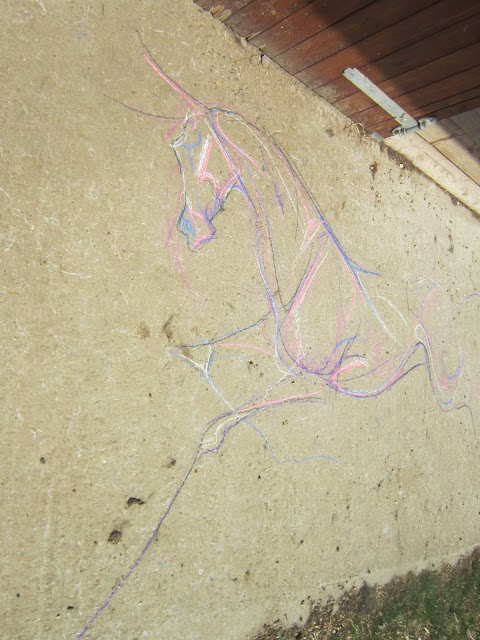Link to YouTube video of me painting on Rocky with horse creams>
CLICK HERE
I decided to try painting on a new surface and what better surface than a horse? I loved the idea of working on the very form I was trying to create, it felt so much more hands on and I felt a better connection to the horse, the connection I've been trying to get with my work. The horses that came out on rocky were far from proportionately accurate but they were far more exciting than the ink drawings I'd done earlier this month in my A3 sketchpad. They felt like pretty Chinese/Japanese art symbolizing beauty and perfectness. -Far from what a horse really is, horses are flawed like us, they'll fart in your face when you pick out their feet and stomp on your toe. These painting I did on Rocky I feel are so much closer to what I want to show with my work, they feel realer and closer to the spirit of the horse.
I had some fun smearing the cream on my hands and painting hand prints on Rocky and this random bit of fun actually completely inspired me to look into Native Indian war paint!
I've been looking into the mark making and meanings of symbols that Native Indians use and am completely fascinated by the respect I've found for the horse in
the culture.
I’ve kind of hit an interesting wall at the moment as I wanted
my horses to stay as natural and close to what I imagine the very spirit of the
horse would be and represent it in my art. But I’m getting more and more
interested in the Native Indian relationship to the horse and spirit of the
horse. Unlike other human relationships to horses such as modern English riding,
Western riding and even the use of horses in war time I feel like the horse is
never as respected and valued as the Native Indians do. I’m not sure where to
go with this and so I’m going to do more research into horses used in war and
the very spiritual side to Native Indians and their animals. I feel like this
will better form my understanding of the use of the horse and how oppressed they
are by us. Can Indians use the horse without oppressing it? Relating this to me
and my horse, I ride very naturally without the traditional saddle and bridle.
My horse is ridden in a halter or parelli collar bareback
and sometimes without any tack at all. I found that when I rode him when he was
younger in tack he felt tight and wooden; he never felt fluid in his movement
and would always have problems tripping on his front and dragging behind. My
horse had problems properly engaging in canter and to motivate him to trot was
horrid! The transition to tackless was hard for both of us at the start.. I
found it hard to balance without a saddle and he found it very difficult to
ride forward without the bit as support as my horse often uses the bit contact
as a source of confidence. Without that connection to the rider he is very
nervous and often will pause when in a new situation or when frightened. So as
time went by without that contact he grew a new confidence in just me and our
body contact, where we could read each other, what we wanted from each other with
the movements of my hips asking him to bend and just feeling his muscles
working underneath me. You can feel the horses muscles tighten when they’re
anxious or excited or feel when they’re ready to make a gait transition from
trot to striking into canter on the right leg.
I feel like humans have tried to contain and control the
horse with all these gizmos we can put on them and it’s just pushed us farther
and farther away from each other. If you can put your trust into the horse,
show the horse that you trust them to carry you willingly without the back up
of all these fixes on them, I feel like you’re making a mutual commitment
rather than always just asking from the horse. Asking the horse to trust you
with when to jump, turn, transition. I feel like the Native Indians felt the
same as me and respected the horse and their feelings. Their tack is made with
consideration for the animal not with the desire to control the animal. They
often ride saddleless and therefore don’t need to tug and hold onto their horses’
mouth with metal but ask with their body language for the horse to slow and
run.
The more I look into Native Indians and modern day Parelli
[natural horsemanship] the more I see it as less and less of a control over the
horse but more a way for the real spirit of the horse to come out and be shown.
A horse will frolic in a paddock with its paddock companions and run wild with
a herd but they can be very docile animals grazing for a great proportion of
the day. But with the natural assistance of a human being the horse form can be
expressed and conveyed. It almost makes this natural spirit more beautiful when
there’s harmony between two spirits.
I'm confused now and will have to give it some thought. Is this what I want my work to represent? Do I want to expand the spirit of the horse or maybe show the spirit of the horse in war? I don't know yet. I'm going to do some further research into Native Indian culture, spiritualism and respect for animals.














































